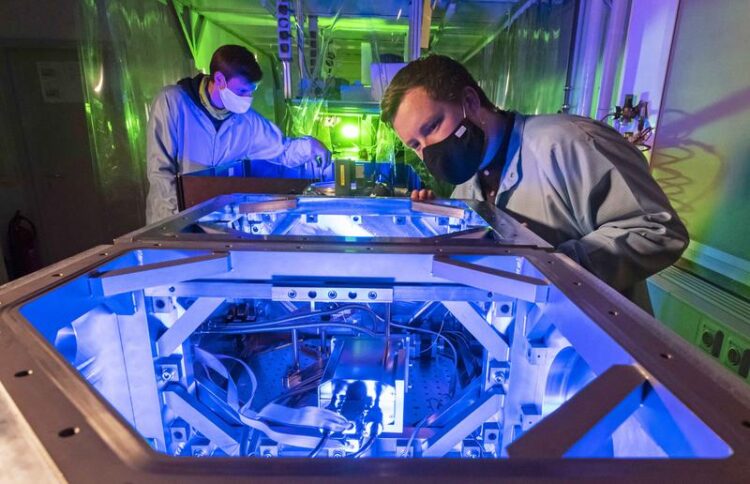Nonlinear Ionization Dynamics of Hot Dense Plasma Observed in a Laser-Plasma Amplifier

Frederik Tuitje (r.) and Tobias Helk from the University of Jena in Germany prepare the setup for an investigation of a laser-plasma source.
Image: Jens Meyer/University of Jena
Understanding the behavior of light-matter interaction under extreme conditions, such as in high-density plasmas, is important for our identification of cosmologic objects and the formation of the universe. Researchers at the Universities of Jena, Germany, California in Berkeley, USA, Madrid, Spain, and the Institut Polytechnique de Paris, France have succeeded in directly observing the formation and interaction of highly ionized krypton plasma using femtosecond coherent ultraviolet light and a novel four-dimensional model.
The last decade has been marked by a series of remarkable discoveries identifying how the universe is composed. It is understood that the mysterious substance dark matter makes up 85 % of the matter in the universe. Observable matter in the universe consists of ionized particles. Thus, a profound understanding of ionized matter and its interaction with light, could lead to a deeper understanding of the relationships at play that formed the universe. While ionized matter, or plasma, is relatively easy to generate in the lab, studying it is extremely challenging as methods that can capture ionization states and density are virtually non-existant.
In a new paper published in “Light Science & Application”, a team of scientists has succeeded in directly observing the formation and interaction of highly ionized krypton plasma using femtosecond coherent ultraviolet light and a novel four-dimensional model.
Eight-fold ionized krypton ions as laser medium
In their work, the researchers employ a laser-plasma amplifier, that uses eight-fold ionized krypton ions as laser medium. Then they launch a coherent extreme ultraviolet probe pulse into this plasma that picks up signatures of the plasma conditions as it propagates through the laser-generated plasma column. This extreme ultraviolet probe pulse is then analyzed by diffracting it off a well-characterized nanoscale target. This method, known as coherent diffraction imaging, allows for measurement of the properties of the probe pulse carrying information about the plasma with very high resolution. “Using an extreme ultraviolet probe pulse with a wavelength short enough so that the plasma becomes transparent to interrogate the formed plasma is key,” explains Prof. Dr Michael Zuerch from the University of California in Berkeley.
Unexpected discovery
“Surprisingly, we found a non-trivial spatial modulation pattern that is unexpected in a waveguide geometry. Using an adapted ab initio theory modelling the plasma-light interaction in four dimensions across multiple scales we can find excellent agreement with our experimental data. This has allowed us to ascribe the observed signal to a strongly nonlinear behavior in laser-plasma interaction generating the highly-ionized krypton plasma,” elaborates Zuerch.
The experimental approach, that can be easily adopted to other relevant scenarios, validates the advanced ab initio models used to simulate the laser-plasma interaction and more generally the formation of highly-ionized plasma. An important ramification of the findings shows that you cannot create arbitrarily ionized plasmas using optical techniques. “The developed model will allow for predicting achievable conditions accurately and gives hope that very defined plasma conditions can be created by appropriate laser beam shaping,” says Prof. Dr Christian Spielmann from the University of Jena. Zuerch summarized the outlook of the work: “Beyond a more profound understanding of laser-plasma interactions, our findings have impacts, for example, on the upscaling of plasma-based X-ray light sources or plasma-based fusion experiments.”
Wissenschaftliche Ansprechpartner:
Prof. Dr Christian Spielmann
Institute of Optics and Quantum Electronics of Friedrich Schiller University Jena
Max-Wien-Platz 1, 07743 Jena; Germany
Tel.: +49 (0)3641 947230
E-mail: christian.spielmann[at]uni-jena.de
Originalpublikation:
F. Tuitje, P. Martínez Gil, T. Helk, J. Gautier, F. Tissandier, J.-P.Goddet, A. Guggenmos, U. Kleineberg, S. Sebban, E. Oliva, C. Spielmann, and M. Zürch. Nonlinear Ionization Dynamics of Hot Dense Plasma Observed in a Laser-Plasma Amplifier, Light: Science & Applications, https://www.nature.com/articles/s41377-020-00424-2
Media Contact
All latest news from the category: Physics and Astronomy
This area deals with the fundamental laws and building blocks of nature and how they interact, the properties and the behavior of matter, and research into space and time and their structures.
innovations-report provides in-depth reports and articles on subjects such as astrophysics, laser technologies, nuclear, quantum, particle and solid-state physics, nanotechnologies, planetary research and findings (Mars, Venus) and developments related to the Hubble Telescope.
Newest articles

Retinoblastoma: Eye-Catching Investigation into Retinal Tumor Cells
A research team from the Medical Faculty of the University of Duisburg-Essen and the University Hospital Essen has developed a new cell culture model that can be used to better…

A Job Well Done: How Hiroshima’s Groundwater Strategy Helped Manage Floods
Groundwater and multilevel cooperation in recovery efforts mitigated water crisis after flooding. Converting Disasters into Opportunities Society is often vulnerable to disasters, but how humans manage during and after can…

Shaping the Future: DNA Nanorobots That Can Modify Synthetic Cells
Scientists at the University of Stuttgart have succeeded in controlling the structure and function of biological membranes with the help of “DNA origami”. The system they developed may facilitate the…



